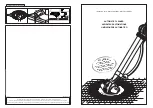
19
ICING REGULATION
The Heatstar unit contains a large refrigeration circuit and the temperature of the cold refrigerated air coil is
maintained near to freezing to optimise heat absorption.
Therefore, ice is expected to form on the refrigerated air coil under certain conditions and this is perfectly normal.
Even when ice has formed on the refrigerated coil, the Heatstar unit is still able to function normally and continue
to heat the pool water.
However, if the ice formation is left unchecked, then the ice will eventually block the air path through the
refrigerated coil and this will impede effective operation.
During warmer weather, the coil temperature would normally be slightly above freezing and no ice will form. As
the air temperature becomes colder, then ice will start to form on the refrigerated coil.
If the pool water temperature is warm, then ice would not normally start to form on the refrigerated coil until the
air temperature falls to around 7ºC. However, if the pool water temperature is cold, then ice may be expected to
form at air temperatures notably higher than this figure.
Heatstar units are available with three alternative types of icing regulation :
SDF (SUMMER DE-FROST) VERSION :
With SDF models the refrigeration system is simply switched off when excessive ice has formed, automatically
switching back on again when the ice has naturally melted.
This is the most common type of icing control and is appropriate for the normal UK summer swimming season.
ADF (AUTUMN DE-FROST) VERSIONS :
With ADF models the heat generated from the heat pump system is diverted away from the pool water heating
coil and into the refrigerated air coil to actively melt away the excess ice.
WDF (WINTER DE-FROST) VERSIONS :
With RDF models the heat pump system reverses it
’s action so that it takes heat from the pool water and
transfers it into the refrigerated air coil to actively melt away the excess ice.









































